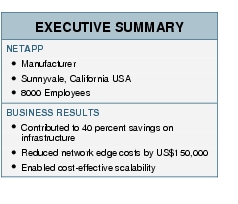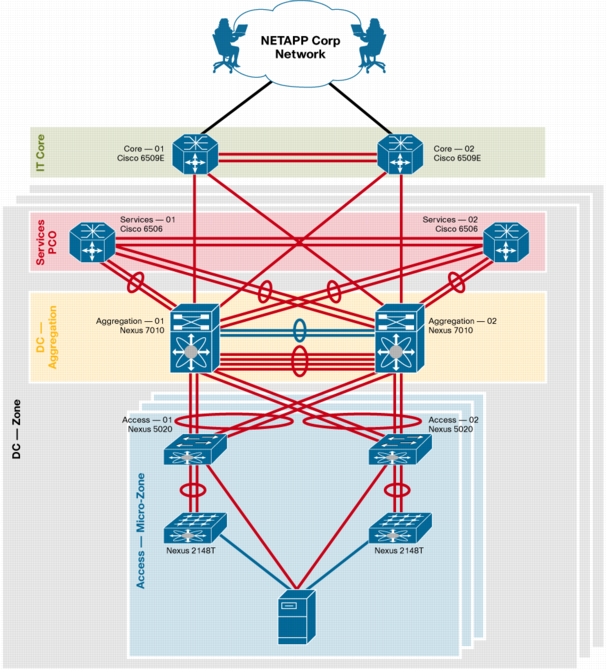NetApp used the Nexus family to build a cloud-computing environment.

Business Challenge
• Meeting the increased I/O and network performance demands imposed by server virtualization
• Supporting higher 10 Gigabit Ethernet demand at the server access layer
• Enabling virtualization features like VMware VMotion and Data Distribution Services (DDS)
• Preparing for future adoption of Fibre Channel over Ethernet (FCoE) and IEEE 802.1 Data Center Bridging (DCB)
• Creating a highly available, scalable, and repeatable design with no single point of failure
Solution and Results
• Reduced capital expense: "Application virtualization reduced our infrastructure costs by 40 percent, and the Cisco Nexus 2000 and 5000 access switches are an important enabler," says Mike Morris, Manager-IT Communications Engineering.
• Network edge cost savings: Rather than deploying two physical switches to separate internal and external traffic, NetApp separated a single physical Cisco Nexus 7000 Switch into two virtual device containers (VDC), each of which connects to a separate Cisco Nexus 5000 Switch. "The VDC support on the Cisco Nexus 7000 saved $150,000 on our DMZ, or 43 percent of the total budgeted costs," says Morris.
![Text Box: "Of all the data center switches we evaluated, the Cisco Nexus 5000 Switch best matched the 300 requirements we identified for application virtualization, including Layer 2 access support, an enhanced 10 Gigabit Ethernet backbone, 10 Gigabit Ethernet server connectivity, and FCoE [Fibre Channel over Ethernet] support."-Kamal Vayas, Team Lead-Data Center Services, NetApp](images/case_study_c36-554435-2.jpg)
• Cost-effective scalability: NetApp built the data center network at the right size to meet current needs and can scale easily as needed to meet fast-paced growth. The modular design of Cisco Nexus switches simplifies scalability. When a microzone needs more ports, NetApp can purchase expansion modules for the Cisco Nexus 5020 Switch or add Nexus 2148 Fabric Extenders instead of purchasing a new switch.
• Reduced management overhead: Management is simplified because the IT department can configure and manage all Cisco Nexus 2000 Fabric Extenders through the Cisco Nexus 5020 Switch, as if they were one device. "We found a lot similarity between the Cisco IOS Software and the NX-OS, so it was a smooth transition to Nexus switches," says Vyas.
• Excellent application performance: The Cisco Nexus 5020 Switch delivers very low latency for 10 Gigabit Ethernet.
• Energy efficiency: NetApp's data center has a hot-aisle/cold-aisle layout. The front-to-back airflow and rear-facing ports on Cisco Nexus switches made it possible to install the pressurized cooling system directly above the cold aisles, significantly reducing cooling costs. The data center has achieved a Power Usage Effectiveness (PUE) rating of 1.2, far exceeding the U.S. Environmental Protection Agency (EPA) recommendation of 2.0.
• Simplified cabling: The rear ports of the Cisco Nexus 5020 Switch simplify cabling from the servers to the switch.
• Support for a unified fabric: NetApp purchased FCoE licenses for the Nexus 5000 Switches to consolidate the separate data network and storage area network into a single fabric.
Technical Implementation

Call to Action